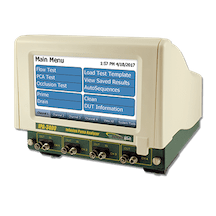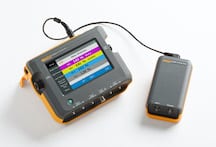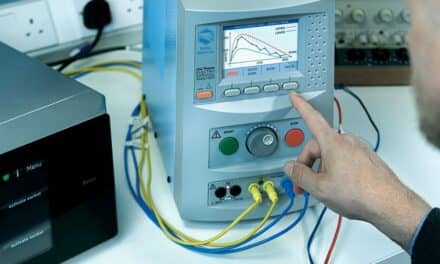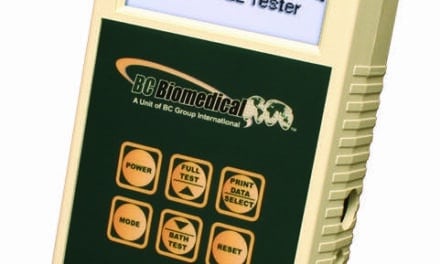Changes necessitated by the COVID-19 pandemic are helping to spur innovation in testing equipment and service. But challenges remain, experts say
By Melanie Hamilton-Basich
The COVID-19 pandemic unquestionably increased demand for biomedical test equipment. Use of ventilators skyrocketed as waves of patients with the disease caused by SARS-CoV-2 filling ICUs struggled to breathe on their own.
Other medical devices needed to administer medications to these patients and monitor their condition also saw increased use, necessitating more frequent testing. And because of the restrictions imposed in hospitals to prevent transmission of the disease, the pandemic forced those operating testing equipment to adapt to changing protocols and rethink how best to approach their jobs. Here’s a look at how the industry is adapting, and what to expect in the future.
COVID-19 and Testing Needs
“As the world came to grips with the tsunami of COVID-19 patients requiring not only hospitalization, but intensive care treatment, we were faced with increased demand for testing emergency department and ICU medical devices,” says Gerald Zion, global technical training manager at Fluke Biomedical in Everett, Wash. “These included not only ventilators, but also patient monitors and infusion devices.”
Zion says the increased demand for testing extended to medical device manufacturers as well. They were tasked with developing new products on an accelerated timeline, which required multiple rounds of testing, in the design phase and for the final product. To meet demand, testing was also needed at newly outsourced production facilities where the employees had never tested medical devices. This required training.
“Whether in the hospital, or on the production line, these challenges required ramping [up] of supply chains and methods for delivering training rapidly,” says Zion. “We are proud to have been able to have the right test instruments, at the right time, and the ability to teach the use of those key test instruments—electrical safety, infusion device testing, and ventilator/anesthesia system testing.”
Ken O’Day, vice president of sales and marketing at St. Charles, Mo.-based BC Group International, Inc., says the calibration facility was the part of his company that faced the largest challenge because of the COVID-19 pandemic. “Our onsite calibration technicians had to deal with the additional restrictions while trying to calibrate test equipment at the customers’ facilities,” he says. “Items that were sent in for depot calibration or repair were subjected to a quarantine period before they could be processed.”
Similarly, technicians had to adjust how they performed service, says Greg Alkire, vice president of sales and marketing at Sun Valley, Calif.-based Pronk Technologies. Many had to postpone routine service and maintenance that wasn’t absolutely critical to focus on the clinical staff’s urgent needs at the time.
“The need for portability and the ability to perform the service required while being minimally intrusive to the staff and patients is a must,” adds Alkire. “Having the flexibility to only take the test equipment that is absolutely necessary—not wheeling in a cart into patient areas, for example—has become more important than ever before.”
Emerging Trends
With the impact of these experiences still being felt throughout healthcare, it’s natural to expect improvements in the industry that would prevent or minimize such difficulties in the future. Companies are also looking to incorporate technological advancements into products that will make work easier and more efficient, pandemic or not.
Fluke’s Zion sees hospitals improving their supply chains for medical devices as well as testing equipment. He also expects to see more standardization of devices so that it won’t be as difficult to both operate them and test them in the future. “The pandemic ‘just-get-me-anything’ reaction came with the ‘how-do-I-make-this-work’ and ‘what-needs-to-be-tested’ challenges,” he says. “Reducing risk to the patient from unfamiliarity with medical devices and getting the medical devices to ‘talk’ to the hospital network while managing cybersecurity and interoperability remain issues.”
To Pronk’s Alkire, it’s all about reducing the administrative part of a clinical engineer’s job while increasing efficiency—something, he says, his company’s Mobilize product platform achieves. (Mobilize, Alkire explains, adds wireless capabilities to an electrical safety analyzer, an infusion pump analyzer, a pulse oximeter tester, a noninvasive blood pressure simulator, and more.) “[Pronk’s] new technologies synchronize the procedures to the test equipment and allow clinical engineers to perform all the steps required and capture all the results and test points wirelessly in a completely paperless way.”
Morevoer, safety is an ongoing concern that the COVID-19 pandemic has brought into even sharper focus. Zion says he’s dismayed seeing “alarming volumes of incidents that should be found during periodic testing.” But he is heartened by the increased acceptance in the United States of the need for incorporating quality assurance testing into workflows.
“End-to-end interoperability with workflow automation and standardized test procedures can and does help,” Zion says. This is because periodic testing creates inputs about failures encountered during testing over time and helps computerized maintenance management systems develop a predictive maintenance plan, instead of the current norm of reactive fixes once something has already stopped working. Zion boils it down to this: “Medical devices sitting idle in a repair queue prevent patient care, and hospital revenue realization.”
Alkire, for his part, believes that the next big thing in testing equipment will likely come from the HTM community itself, if companies will listen. “Test equipment companies that can harness the talents of clinical engineers’ ideas into the design of the test equipment will leapfrog in creating solutions that really drive a win-win environment for everyone,” he says, “including providing the best healthcare possible for patients.”
Technologies to Watch
In the meantime, new testing products are currently available to better meet users’ needs. Take BC Group’s patented IPA-3400 Infusion Pump Analyzer, for example. O’Day says this device is the culmination of feedback from field users—a fact that has proven even more important in light of increased demand for and stress on test equipment over the past year. For one thing, the IPA-3400 Infusion Pump Analyzer can hold up to four channels so four pumps can be tested at the same time, vastly increasing efficiency.
In addition, each of the channels can be removed by the user and sent in individually for repair or calibration, instead of having to lose use of the entire device. O’Day says this is a unique feature that also allows the user to upgrade the unit in the field “just by purchasing additional flow modules and plugging them in.”
Then there’s Pronk’s new Mobilize platform. “Clinical engineers can streamline their testing to the point where they can eliminate all manual documentation, have the flexibility to create custom automated (including standardized) testing protocols, and integrate extensively with a CMMS,” says Alkire. “All of this is possible, right from their smart device.”
Another testing device that has been working overtime—particularly amid the pandemic—is Fluke’s VT900A gas flow analyzer. As healthcare facilities used more ventilators to treat COVID-19 patients, they began testing the devices using an updated version of the VT900A and an accessory called VAPOR that expanded the VT900A’s capability to test all medical devices that exert a gas pressure or produce a gas flow, Zion says. In response, Fluke further improved its VT900A by adding interoperability with the company’s OneQA workflow automation software suite.
“This allowed for standardization of testing procedure workflow, minimizing sources of human error, and making the testing and documentation much more efficient than ever before,” says Zion. “OneQA also already incorporates interoperability with our electrical safety analyzers and the IMPULSE7000 defibrillator/pacer analyzer.”
Facing Challenges Head On
Looking ahead, companies are doing their best to address difficulties in developing new testing equipment.
Alkire says one of the biggest challenges now and going forward is trying to get in on the design phase of medical devices. It’s important to actively collaborate with manufacturers at the very beginning to incorporate service methodologies “to utilize test equipment as an integrated part of the medical device,” he says. “This is the next frontier we are focused on: creating synergies at the very ground level to ensure medical devices are serviced and maintained at the highest level.”
O’Day agrees that this would greatly improve the accuracy and efficiency of testing equipment, but says, for now, BC Group is doing the next best thing. “The need is constantly there to develop or improve existing devices in the field,” he says. “Most of our devices allow for software updates in the field at no charge to the customer. These updates are automatically provided if the device is calibrated by BC Group.”
The challenges Zion sees in creating test instruments include intuitive user interfaces; rapidly and appropriately responding to medical device innovations (which, he says, occur before the minimum performance and safety standards can respond and include such testing); improving on-demand user training about the test instrument itself; and interoperability with other systems for two-way communication of information for scheduled testing, and long-term trending of failures.
Zion is also concerned about the major shift to homecare that COVID-19 caused, requiring an unprecedented amount of self-monitoring device use. “Who was testing those, often locally sourced not-approved-for-hospital-use devices? How were they being tested? What test instruments and standards were being applied to ensure patient safety?” Zion asks. “All these challenges remain, even after the pandemic is over.”
What remains to be seen is how the industry will address these issues.
Melanie Hamilton-Basich is associate editor of 24×7 Magazine. Questions and comments can be directed to [email protected].








